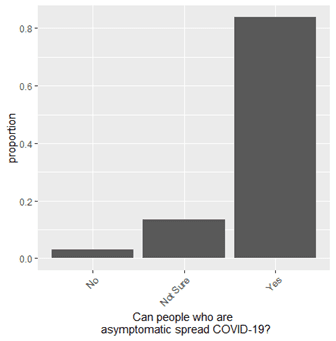In our second report drawn from the Living in Boston During COVID survey, we have focused on contrasting themes of fear and ambivalence among Bostonians. On the one hand, there appears to be broad consensus that the virus is dangerous, that social distancing guidelines are important, about wearing masks and avoiding high-risk activities, and that asymptomatic spread is a concern. However, the proportion of respondents who differed on these views is non-trivial and varies substantially by neighborhood, race, and income. These variations can help us to understand the vulnerabilities that different communities face as cases surge this winter. In today’s data story, the last of four from this report, we focus on beliefs about asymptomatic spread.
One of the most challenging parts of both understanding and managing COVID-19 is the ability of asymptomatic individuals (i.e., those who are “infected” by the virus but not showing any symptoms of sickness) to transmit the disease. The survey asked whether, in the respondent’s opinion, this was the case.
As shown in Figure 1, the vast majority (86%) of respondents believed that asymptomatic spread of the disease was possible, showing strong agreement with the established science. On the flipside, however, that means that 14% of people indicated that they were “not sure” or did not believe that transmission by asymptomatic individuals was possible. This might be the minority, but it is still concerning. A non-trivial proportion of individuals whose calculation of risk and personal choices might be predicated on this misunderstanding, and this very well might be higher in certain communities.

Figure 1. Belief in asymptomatic spread among respondents.
As we map the distribution of beliefs about asymptomatic spread across neighborhoods in Figure 2, we see that they appear to hang tightly with socioeconomic status. In affluent western neighborhoods like Roslindale, Jamaica Plain, West Roxbury, and Allston and Brighton, nearly all respondents agreed that asymptomatic spread was possible. Meanwhile, southern neighborhoods like Hyde Park, Mattapan, and South Dorchester had the greatest number of respondents who felt differently.

Figure 2. Percentage of individuals who did not believe that asymptomatic individuals could spread COVID-19, by neighborhood.
These geographic differences manifested in marked demographic differences. Racially, we see that among Black and Latinx respondents approximately 25% and 35%, respectively, did not fully believe that asymptomatic spread was possible (though not visualized here). Similarly, looking across the economic spectrum (see Figure 3), over 25% of respondents making <$30,000 annually felt this way while almost every respondent making more than $75,000 per year believed that asymptomatic spread was possible.

Figure 3. Proportion of individuals who did not believe that asymptomatic individuals could spread COVID-19, by income level.
This was our last data story from the second report on the Living in Boston During COVID survey. We again see two recurring themes. First, there is seeming consensus about the pandemic and how to properly navigate it—but there is still enough dissension from this consensus to create vulnerabilities for communities. Second, the form that these vulnerabilities take will be critical to how policymakers and practitioners support communities during the second wave. As we turn to the second, the story has changed from the previous data stories. We saw more high-risk behaviors and ambivalence toward risk and guidelines in more affluent, majority White communities. Today we see that communities with lower income and education levels had more residents that did not fully understand asymptomatic spread. This reflects a distinct vulnerability for transmission within the community, and one that merits close attention from policymakers and practitioners, especially as we are forced to manage a second surge of the pandemic.
The content of this post is drawn from the Living in Boston during COVID survey conducted by the Boston Area Research Initiative, the Center for Survey Research at UMass Boston, and the Boston Public Health Commission. It was funded by the National Science Foundation’s Human-Environment and Geographical Sciences (HEGS) program through a grant for rapid-response research (RAPID; Award #2032384). The results presented here were part of a longer report on “Inequities in Navigating a Pandemic”.

